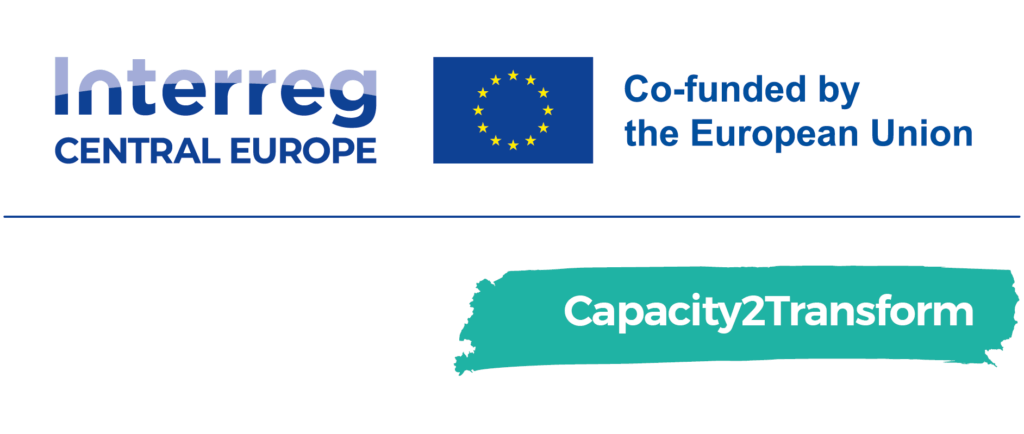Innovation is often seen as the key to staying ahead in today’s fast-paced world, but what defines innovation and how does it work practically?
The answer lies in “co-creation”. What is co-creation? It is a dynamic, collaborative process where diverse stakeholders come together to jointly develop solutions that are both creative and practical. It is a great method to turn abstract ideas into effective solutions that meet the needs of the target audience. The “co-creation workshop” held on 18-19 March 2025 in Karlsruhe in the frame of the EU project Capacity2Transform gave participants from the tourism and creative industries the opportunity to use this method and find out how to develop successful innovations.
Innovation through co-creation
The key benefit of co-creation is its collaborative nature. Bringing together people with different expertise and perspectives leads to creative solutions that would not be possible within a single discipline. In this process, each participant contributed valuable knowledge. To harness this diversity effectively, structured methods and tools were introduced regularly to provide a clear framework and keep the process focused. One such method was Design Thinking – a user-centred approach that focuses on problem-solving and iterative prototyping. It encouraged participants to explore challenges from different perspectives and pushed them to move beyond familiar thinking patterns.
Benjamin Blankenburg, who facilitated the workshop, played a pivotal role in guiding the teams throughout the process. His structured yet flexible approach created space for creative exploration while consistently steering the group back to the core challenge and its practical constraints. This balance ensured that the workshop stayed focused on achievable outcomes, remained rooted in user needs and fostered a flow of fresh ideas. His support helped the participants shift between roles of “dreamer”, “realist”, and “constructive critic”, allowing them to develop bold ideas that would evolve into grounded, actionable plans.
Projects in Focus – CoupinoApp and Ortenau Wine Tourism
Two real-world challenges were the central focus of the German co-creation Workshop: The CoupinoApp and the development of a unique tourism event for the Ortenau Wine Region.
CoupinoApp
The App was initially developed to offer budget-conscious tourists coupons and free experiences, encouraging them to explore new activities. Now, the app is evolving to focus on young families, helping them find affordable yet especially enjoyable local experiences. The aim is to attract more tourists and to also inspire locals to reconnect with their own city and surroundings – enjoying regional attractions instead of always looking elsewhere for holiday experiences. Ultimately, the app is designed to support local businesses by attracting visitors while offering users meaningful and memorable moments.
Using the Business Model Canvas, the team refined their business model and shifted their focus toward more focused target groups. This rethinking process involved critically examining the existing model and exploring ways to better understand the needs and preferences of potential users. To support this, the team considered conducting customer surveys and using targeted questionnaires – tools that could validate the concept, provide deeper insights and guide future development.
Ortenau Wine Tourism
The Ortenau wine region, renowned for its beautiful vineyards and rich wine culture, has long been an insider tip – but is struggling to gain the wider attention it deserves. The challenge was to develop wine tourism activities that were not only family-friendly but also appealing to young professionals. These individuals are looking for memorable unique events that offer a mix of sophistication and fun. The team focused on developing event concepts that showcased the unique charm of the region by combining wine tasting with experiences tailored to a younger, adventure-seeking audience.
Through an open brainstorming process, they explored a wide range of ideas – initially without limitations – to spark creativity and innovation. Once a clearer understanding of the target group and its needs was established, the ideas were refined and narrowed down, ultimately resulting in one concrete event concept. The overarching goal was to position the region as a must-visit destination for young, curious travellers seeking a mix of discovery, enjoyment, and authenticity.
The key takeaway
It is crucial to find a problem worth solving before looking for potential solution. Innovation is not so much about a good idea, but rather about bringing it successfully to the market. Co-creation is not just about generating ideas; it is about turning those ideas into reality and equipping participants with the tools and knowledge to innovate within their own organizations.
The workshop provided a balanced mix of theory and hands-on practice. Participants not only learned new tools and methods, such as Design Thinking and Business Model Canvas, but also applied them to develop tangible solutions. Additionally, the workshop fostered valuable connections among professionals from various sectors, including marketing, design, and tourism promotion. This exchange not only enriched the projects but also paved the way for future collaborations. To continue the journey, both projects will present their progress in a video pitch, to showcase their innovative ideas and solutions, opening doors to new funding, clients, and partnerships.
Share the article

